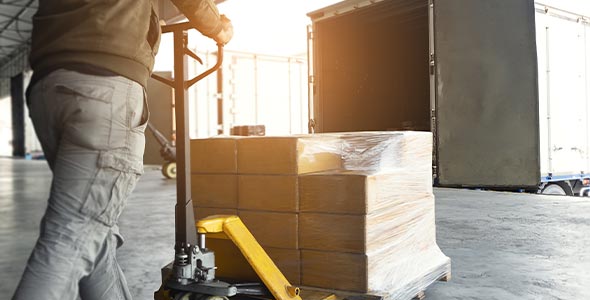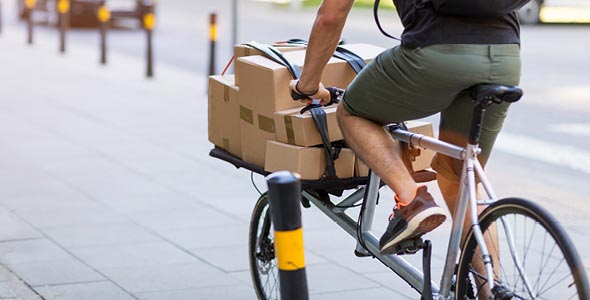How can the environmental impact of transportation be reduced?
If you’re a manufacturing business, being eco-friendly is not just about the product you sell, but how you package it and how you deliver it to customers.
If you’re a manufacturing business, being eco-friendly is not just about the product you sell, but how you package it and how you deliver it to customers.
The recent increase in global supply chain bottlenecks and shipping costs has highlighted the importance of transportation for product manufacturers. It is a major part of supply chains and overall corporate cost structures. Transportation and distribution also produce roughly 25% of all greenhouse gas emissions in the Eurozone with product shipping accounting for at least a third of that total.
The details of the European Commission’s recently announced plans to cut greenhouse gas emissions further have yet to be settled, but it is clear that everyone and every business will be expected to minimize their carbon footprints in the environment.
With the ongoing shift to e-commerce and online shopping, good packaging and shipping practices are crucial to both your operating costs and your environmental profile.
Start with a Package
Optimizing the logistics of delivering products to consumers begins with a package. If it is too small or not robust enough, products can get damaged, and those damages are often direct losses to their manufacturers. The resulting product returns and new shipments can also double or even triple the environmental costs of the transaction compared to a successful delivery.
There is, however, such a thing as over-packaging. The pandemic induced surge in e-commerce and demand for packaging over the past 18 months has brought the issue to a head. Too much packaging not only uses more raw materials it requires more energy to transport. Packages that more closely fit their products require less or no fill to protect their contents. They also cut down on the problem of “shipping air,” which is far more expensive than it sounds.

Rightsized packages also take up less space in a delivery truck, allowing more product to be delivered in a single load and reducing the number of shipments required. They also lend themselves more readily to packing systems using reusable wooden pallets with collars than can secure goods more effectively and with less packaging material.
Pick good partners
A good way for businesses to tackle these issues is to pick good partners. Not all transport carriers and logistics firms are the same when it comes to environmental performance. In assessing these firms, ask for information about their records regarding the environment.
Do they carry the EU Ecolabel, which provides companies with guidelines to lower their environmental impact? What kinds of ISO certifications do they have for their operations? In France, the French Agency for Ecological Transition (ADEME), requires transport providers to inform users about their carbon dioxide emissions and provides tools to compare the information across service providers.
Don’t be afraid to ask more granular questions about how companies look to reduce their carbon footprints.
- How close are a shipper’s distribution centers to your customers? The longer the distance to travel, the less eco-friendly the transaction.
- What kind of vehicles do they use in their business? Emission-less electric, diesel-guzzling dinosaurs or something in between?
- Do they employ geo-location technologies to optimize their transportation routes?
- Do they monitor tire pressure closely to ensure maximum fuel efficiency of their vehicles?
One key area to understand about shipping companies is how they fulfill the last leg of product deliveries to the end customer.
The last kilometer
In product shipping, the last kilometer, (or thereabouts), is the most important one. The trip from a warehouse or distribution center to the end customer accounts for at least half of the total shipping costs of a delivery by most estimates. With all the short trips to multiple locations often in congested urban environments, it likely contributes at least half of the carbon emissions of a typical delivery.
Electric vehicles are an obvious, if initially expensive, solution. IKEA, the world’s biggest furniture retailer, has committed to using electric heavy-duty trucks to complete its deliveries. Its transport company partners already have all electric fleets serving a number of large cities such as Paris, Shanghai and New York and IKEA plans to have zero emissions from all its global last kilometer deliveries by 2025.
Whenever possible, companies without overly bulky products should also consider using green fleets of bicycle couriers and cargo-cycles to deliver packages to individual homes and offices. They reduce urban congestion, limit stress on infrastructure and produce virtually no GHG emissions.

The objective of better last kilometer logistics is faster, more efficient, and more eco-friendly product deliveries. It often involves managing large fleets of vehicles in dynamic, changing situations. It is also about coordinating collection points with delivery capacity and combining deliveries with pick-ups and returns to minimize empty trucks. Not surprisingly, many firms use technology to help with all the information. Software from firms like Brussels-based Urbantz manage all variables involved in last kilometer logistics.
To go further
Another viable option is to outsource the task to an experienced logistics firm. Either way, the process begins with smart packaging that uses less material, cuts down on warehouse costs, and reduces the carbon emissions involved in getting a product to the customer.
_________________________________________
Sources:
EC Europa, 2020, Transport emissions
Global tranz, 2019, Transportation costs
Nefab, 2016, Total cost of logistics
ADEME, 2019, Ecolabel
MotorWorld, Ikea to electrify the last kilometer to Canada with lion electric








